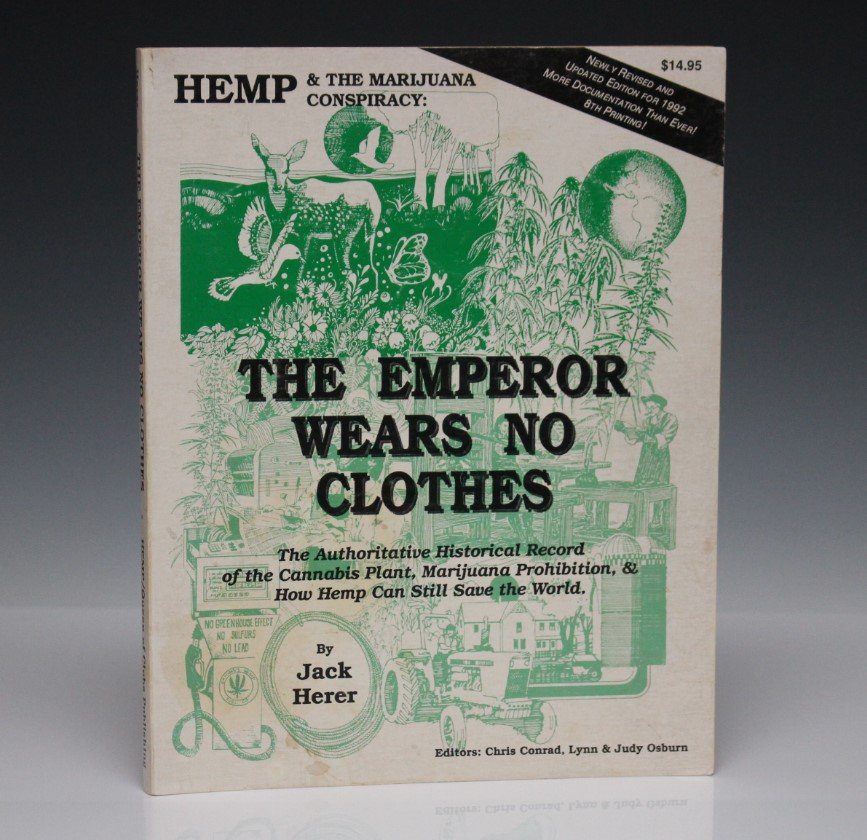There seems to be no end to shameless conspiracy theories about the origins of cannabis prohibition. Among the most disseminated are that William Randolph Hearst wanted to ban hemp to protect his vast timber holdings and that the DuPont corporation wanted to eliminate competition to their newly patented thermoplastic – nylon. The evidence supporting both sounds better when you’re high.
But consider this:
“The debasing and baneful influence of hashish and opium is not restricted to individuals but has manifested itself in nations and races as well. The dominant race and most enlightened countries are alcoholic, whilst the races and nations addicted to hemp and opium, some of which once attained to heights of culture and civilization have deteriorated both mentally and physically.”
Dr. Albert Emile Fossier wrote these words in his paper, The Marihuana Menace which he presented during the conference of the Louisiana State Medical Society, April 14-16, 1931, and was later published in the New Orleans Medical and Surgical Journal (Vol. 84 July 1931-June 1932). Fossier’s paper was not the first public call to arms regarding the looming threat of “marihuana” use; however, his overt use of racism is quintessential to “reefer madness,” as we know it.
Fossier opens “The Marihuana Menace ” by retelling the legend of “the religious cult or sect the Assassins,” which per Fossier’s narrative, was founded in “Persia” around 1090 AD. An offshoot of the Islamic Shiite sect, the Assassins were supposedly given hashish as part of a ritual which made them susceptible to being programmed into committing acts of murder. Fossier continues to frame the threat of marihuana as an existential conflict between civilizations stating, “During the time of the Crusades, they (the Assassins) resorted to every kind of violence. Their utter disregard for death and the ruthlessness of their atrocities presented a formidable obstacle to the arms of the Christians.”
Fossier’s narrative is written to elicit images of the Persian horde swarming Leonidas and the 300 while suggesting that marihuana was part of a “ruthless…obstacle” in the Christian crusader’s attempts to liberate the Holy Land. More importantly, Fossier conveys that marihuana, an existential threat from antiquity, now threatens the shores of the homeland.
Fossier was not the only prominent citizen in New Orleans attempting to alert people to the “threat” of marihuana. In 1931 NOLA District Attorney Eugene Stanley authored “Marihuana as a Developer of Criminals” for the official sounding American Journal of Police Science. The article borrows heavily from Fossier’s paper, cited in the references. Stanley’s article was later entered as evidence/testimony during Congressional hearings preceding passage of the Marihuana Tax Act of 1937. Meanwhile Fossier was cited as an expert in the field of cannabis abuse in the 1937 film “Assassin of Youth”.
Films like “Marihuana: Assassin of Youth” and “Reefer Madness” were originally screened to parent and church groups for “educational” purposes and to generate public support for marihuana prohibition. The cause of marijuana prohibition found a national voice in William Randolph Hearst, who used his network of newspapers to sensationalize the threat of marihuana. The message was simple; marihuana, the intoxicant of the inferior races was rapidly becoming an existential threat to Western civilization by coming for your children. Hearst had used his newspapers as bully pulpits for years, whipping up hatred by portraying minorities and people of color as subhuman and under the influence of strange substances. …and it worked.
In 1930 the Federal Bureau of Narcotics was created to help enforce laws against cocaine and opioids prohibited by the Harrison Narcotics Act of 1919. Harry Anslinger was appointed its first director, a position he held for over 30 years. In 1931 when Fossier, Stanley and the first anti-marijuana groups appealed for federal interdiction, Anslinger rebuffed their pleas citing both a lack of resources in his newly created agency and the lack of perceived threat posed nationally by marihuana.
Then, in 1932 things changed. The 19th Amendment was ratified repealing the national prohibition of alcohol. This had the side effect of making hundreds of Treasury agents, who had previously been tasked with enforcing alcohol prohibition, obsolete. Meanwhile, over at the FBN the threat of heroin and cocaine did not require a huge increase in law enforcement. Many academics and political scientists have postulated that bureaucracies, such as the FBN, become almost like living organisms and tend to defend their own territory and grow wherever possible. Essentially, bureaucrats want to expand their power and their number of subordinates. By 1936 Anslinger had determined that pursuing cannabis prohibition was the way to grow his fiefdom, since with alcohol he could no longer. In taking up the cause of cannabis prohibition he was taking up a fight against a foe that was already being billed as a threat to the current social order.
The most basic form of social control is the “law”. The function of the law is to codify desirable and undesirable behavior. Laws are designed to preserve and expand the power and influence of a society’s dominant group.
 The United States was conceived in racism. At the birth of our nation, the “ruling class” was composed of wealthy, white property owners often affectionately referred to as the “founding fathers.” Originally, in order to reserve power for themselves and those like them, only white male property owners were allowed to participate in “democracy.” In 1789 in 8 of the 13 original states black people were considered property. For purposes of power, sharing this property was considered 3/5 of a person when conducting the official census for Congressional representation.
The United States was conceived in racism. At the birth of our nation, the “ruling class” was composed of wealthy, white property owners often affectionately referred to as the “founding fathers.” Originally, in order to reserve power for themselves and those like them, only white male property owners were allowed to participate in “democracy.” In 1789 in 8 of the 13 original states black people were considered property. For purposes of power, sharing this property was considered 3/5 of a person when conducting the official census for Congressional representation.
The Civil War ended slavery in the United States, but it didn’t end racism. The 14th and 15th Amendments codified the rights of black men supposedly protecting their right to vote. In the former slave states of the Deep South this produced a vicious backlash of local laws that collectively became known as “Jim Crow .” These local laws and ordinances were enacted to put people in their “place” and preserve the social order. Marihuana prohibition is no different.
Racism, that’s the motivation behind marihuana prohibition. Marihuana melts social boundaries and helps people see their common humanity. You can’t have that in a culture built on the concept that some men are considered property.
So, what about DuPont and the great industrial conspiracy? The DuPont theory is heavily promoted in Jack Herer’s The Emperor Wears No Clothes. Herer bases this claim on a few lines from DuPont’s 1937 Annual Report. He writes, “DuPont was anticipating ‘radical changes’ from the ‘revenue raising power of the government…converted into an instrument for forcing acceptance of sudden new ideas of industrial and social order.” In a classic example of making the evidence fit the argument, Herer determines that the statement is regarding the impending passage of the Marihuana Tax Act of 1937. Herer ignores the far larger anticipated impact of the Social Security Act.
While the Social Security Act was passed in 1935, it was not ruled Constitutional by the Supreme Court until 1937. The creation of Social Security had a far greater impact on the nation’s social order while in essence creating a “tax” in the form of Social Security matching funds that employers were obligated to pay.
DuPont was in fact a huge consumer of cellulose, which it converted into products like cellophane and explosives. The unnamed author of The New Billion Dollar Crop even mentions a major power company that consumes billions of tons of cellulose for the manufacture of TNT and dynamite. If this unnamed company is indeed DuPont, hemp cellulose theoretically offered a massive increase in profit margin by flooding the market with raw material.
Likewise, Randolph Hearst didn’t print sensationalist, racist propaganda to protect his vast timber holdings. He did it because he was a bombastic bigot heavily invested, profiting in fact, on maintaining the current social order. Part of his vast wealth was publishing newspapers. Much like Fox News today Hearst exploited fear and social division to help his advertisers sell aspirin and laxatives. And Hearst’s alleged vast timber holdings Herer mentions? Largely a myth. Surely if Hearst were smart enough to amass a fortune, then he would have seen the value in basing his publishing empire on a renewable crop and preserving his “timber” for bigger projects.
No, racism is inarguably at the root of reefer madness and ultimately cannabis prohibition. And, if racism was not the motivation for the making of cannabis illegal initially, then the execution of the law, which saw blacks and people of color arrested and incarcerated at more than double that of whites and sentenced to much longer jail terms, certainly provided the law with plenty of racist cred.
This Black History Month open your eyes, and your mind, to the reality that the easiest explanation is often the truth. Was cannabis prohibited because DuPont and Hearst conspired to protect their own self-interest or did the United States, which has been racist AF since its inception, pass a law to preserve the dominant social order? The simplest answer is usually the correct one.


